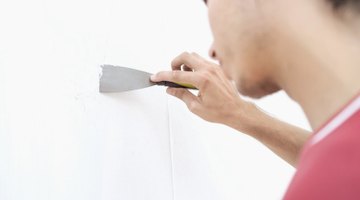How to Use Vinyl Spackling
Spackling is useful in filling in holes and cracks in surfaces before repainting your home. Vinyl spackling contains elastic polymers that slightly flex with temperature changes. This type of spackling does not dry out and crack or crumble after several years as the original spackling does.

Surface preparation before apply vinyl spackling is important to allow the compound to adhere to the drywall, wood or stone surface.
Things You Will Need
- Paint brush
- Chisel
- Putty knife
- Sandpaper
Tip
Do not leave the lid off the spackling compound between coats. This product dries quickly when the container is open.
-
Clean the area around the hole or crack with a dry paintbrush. Pull any hanging Sheetrock paper off the wall to smooth the area around the damage. Chip any splinters of wood away from a hole or crack with a chisel.
-
Insert a small putty knife into the can of vinyl spackling and stir the contents until it is uniform in color and texture. The contents of stored spackling tend to separate.
-
Dip the tip of a putty knife into the spackling and place the knife just above the repair area. Wipe the putty knife down into the crack or hole while applying pressure to force the compound into the damaged area.
-
Fill deeper holes with spackling compound by inserting a larger amount of spackling into the hole.
-
Smooth the spackling to the same height as the surface around the damaged area with the putty knife. Allow the spackling to dry completely. Spackling is a gray color when it is wet and it dries to a white color.
-
Add additional coats to fill very deep holes. Let the repairs dry completely and lightly sand with wet sandpaper before painting.
The Drip Cap
- Spackling is useful in filling in holes and cracks in surfaces before repainting your home.
- Clean the area around the hole or crack with a dry paintbrush.
- Fill deeper holes with spackling compound by inserting a larger amount of spackling into the hole.
- Smooth the spackling to the same height as the surface around the damaged area with the putty knife.
Writer Bio
Mary Lougee has been writing for over 10 years. She holds a Bachelor's Degree with a major in Management and a double minor in accounting and computer science. She loves writing about careers for busy families as well as family oriented planning, meals and activities for all ages.
Photo Credits
- Stockbyte/Stockbyte/Getty Images
- Stockbyte/Stockbyte/Getty Images
More Articles


